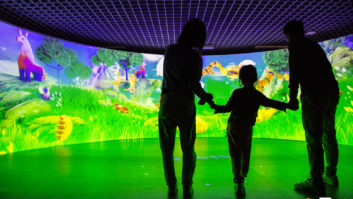How does electronics giant Sharp keep pace with the rapid evolution of domestic TV viewing technology? Sharp UK’s Martin Arnold discusses consumer HD migration and the company’s future product plans.
Q: In what ways are the new Aquos LED LCD TVs a significant addition to Sharp’s residential technology range?
>
A: TV is an exciting area for Sharp, which has a strong heritage in TV technology innovation. Sharp has demonstrated its commitment to growing market share in Europe with a sizeable investment in European facilities for both module production and TV assembly. We have also recently opened our 10th generation LCD panel production facility in Sakai, Japan, for which Europe represents the biggest overseas market.
The Quattron TV highlights Sharp’s picture engineering know-how, making the brand a strong contender in the TV sector and placing it on the consideration list of consumers looking to buy a new TV. Four-colour technology is an important development for the television market. Not only does the technology visibility improve the quality of the colours on screen, the widened colour palate helps with image clarity and definition – providing a better viewing experience.
>
Q: How will you be seeking to convey the benefits of the four-colour technology to your consumer base?
>
A: Sharp UK has invested significantly in the marketing campaign for the Quattron TV. The advertising campaign is a through-the-line campaign covering TV, outdoor and print executions. The campaign kicks off with an eight-week TV campaign pre-World Cup through to the end of June. This will be supported by an outdoor campaign on the national rail network and underground as well as a four-month print campaign running to the end of August, spanning gadget, tech, specialist, men’s and lifestyle titles.
Q: Domestic TV viewing technology is changing rapidly, so how do you keep track and make sure that you respond appropriately? And what else can be done to encourage consumer migration to HD?
>
A: Sharp Electronics has been heavily involved in the development of LCD TV technology from very early on, and as such we’ve had a great deal of experience in observing how the market develops. Technological developments are obviously a major driver, but the fundamental point is that those developments must always offer a demonstrable benefit to the viewer or consumer. When you get that right, then the new technology will be adopted across the market.
As such, we pay particularly careful attention to what our customers are saying about what they want to see in their televisions. That’s why we haven’t immediately jumped on the 3D bandwagon, even though we’ve had the technology for a number of years. People want technology that will give them an enhanced viewing experience of content that is already available, or will be soon. That means offering better picture quality to be able to fully enjoy the HD content that is now becoming available, and Sharp’s proprietary four-colour technology built in to our new range of Quattron TVs is an important development to answer this need.
Not only does the technology visibly improve the quality of the colours on screen, the widened colour palette helps with image clarity and definition, providing a better viewing experience. Sharp is the first manufacturer to use this technology and we expect it to be a great success. From a manufacturing perspective, developments such as four-colour technology enhance the HD experience and contribute to encouraging more and more customers to enjoy HD content.
Q: What can you tell IER about other residential technology developments currently in the pipeline?
>
A: Sharp Electronics (UK) is set to introduce two Freeview HD products in time for the 2010 World Cup. Designed to receive and record Freeview HD services, the TU-T2HR32 [available in May] features a 320GB hard disk drive and dual DVB-T2 tuners, allowing users to watch one channel while recording another. With a user-friendly interface, the box supports HD up to 1080p and standard-definition broadcast upscaling (1080p50), and has HDMI output, Dolby Digital Plus, and an Ethernet port for interactive and future internet-based services.
Meanwhile, Sharp’s TU-T1UR [also available in May] is a Freeview+ DTR with USB recording. Three USB ports on the front panel allow you to play your recordings back on a PC or a second TV with USB port. You can also watch pre-recorded items while recording live TV, copy recordings from one device to another and schedule series recordings. Other functions include audio description and subtitle recording, while parental controls and eight-day programme guides allow for forward planning.
In addition, we’ve also recently launched two ranges of products, called Plasmacluster Ion Generators, with groundbreaking technology new to the UK that is effective in protecting against a number of common viruses, including human, bird and swine flu.
Paul Molyneux was talking to David Davies.
>






